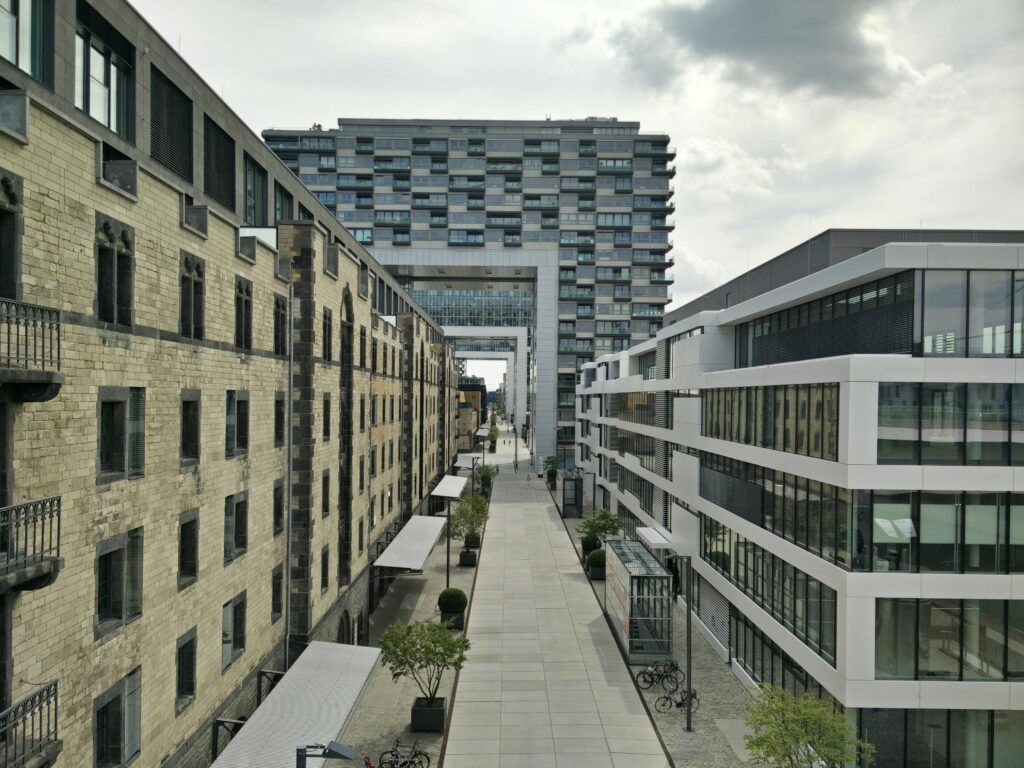Bridge engineering is one of the most intricate and vital aspects of civil engineering, often requiring innovative design, expert knowledge, and creative solutions to overcome various environmental and structural challenges. These spanning structures not only facilitate transport but also symbolize human ingenuity and perseverance. Whether over rivers, valleys, or urban landscapes, the process of constructing a bridge is laden with technical challenges and triumphs. This article will delve into the complexities of bridge engineering, the obstacles faced, and the innovations that continue to drive the field forward.

SRC: https://www.pexels.com/photo/pathway-between-white-and-brown-high-rise-buildings-280212/
Understanding the Fundamentals of Bridge Design
At the core of every successful bridge is an expertly crafted design that considers the load-bearing requirements, environmental factors, and longevity of the structure. The design process involves choosing the correct bridge type suspension, beam, arch, or truss based on factors such as span length, topography, and the type of traffic the bridge will carry. Engineers also have to consider dynamic forces like wind, temperature variations, and vibrations caused by moving loads. These variables, if not accurately accounted for, could compromise the bridge’s stability.
To counter these forces, engineers use a combination of high-strength materials such as steel, concrete, and advanced composites that provide both flexibility and durability. Designing a bridge is a delicate balance between aesthetics, functionality, and structural integrity. It is a field where precision meets creativity, and even a small miscalculation can lead to costly errors or, worse, structural failure.
Overcoming Environmental Challenges
Bridges are often built in some of the most challenging environments, including over deep waters, rugged valleys, or densely populated urban areas. These environments present unique engineering hurdles. For example, constructing a bridge over a wide river requires detailed geotechnical analysis of the riverbed and consideration of water flow dynamics to ensure the piers and abutments can withstand erosion and pressure from flowing water. Additionally, engineers must work around existing natural and man-made obstacles, ensuring that construction has minimal impact on the surrounding ecosystem.
In many cases, environmental factors can delay construction timelines or require the use of innovative techniques to minimize risks. In urban settings, for instance, engineers may need to design structures that fit within tight spaces, all while limiting disruptions to existing infrastructure and services. Such limitations often necessitate the development of customized construction methods, such as prefabrication, that speed up the building process while maintaining safety and quality.
Engineering Triumphs: Innovations in Materials and Techniques
The engineering challenges posed by bridge construction have spurred numerous advancements in materials and construction techniques. Today, engineers have access to a variety of modern materials that can extend the lifespan of a bridge and make it more resistant to both wear and environmental degradation. One notable innovation is the development of fiber-reinforced polymers (FRP), which are not only lightweight but also offer high resistance to corrosion, making them ideal for bridge decks and reinforcement.
Additionally, construction techniques such as incremental launching and segmental construction have made it possible to build longer spans with greater precision. These methods allow for sections of a bridge to be built incrementally and then assembled on-site, reducing both construction time and the need for extensive scaffolding. The application of drones and sensors for real-time monitoring during construction also provides engineers with valuable data to ensure structural integrity throughout the process.
Navigating the Complexities of Large-Scale Bridge Projects
Large-scale bridge projects, such as those spanning wide rivers or connecting cities across vast distances, present an additional set of complexities that go beyond engineering. Projects like the Akashi Kaikyō Bridge in Japan or the Millau Viaduct in France required not just technical expertise but also seamless coordination between government bodies, construction firms, and local communities. These types of bridges, often referred to as mega-projects, involve significant financial investment and extensive planning.
Challenges such as land acquisition, environmental impact assessments, and public consultation must be managed with care to avoid delays or cost overruns. Furthermore, such projects often involve collaboration between international engineering teams, which requires clear communication and adherence to universal safety and quality standards. Despite these challenges, large-scale bridges often serve as triumphs of engineering, showcasing the capacity of human ingenuity to connect distant places and improve the movement of goods and people.
Future Trends: Sustainability and Smart Bridge Technology
As with many other sectors of civil engineering, sustainability is becoming a central focus in bridge design and construction. Engineers are increasingly tasked with creating bridges that not only minimize environmental impact during construction but also reduce long-term maintenance costs and energy use. Green materials, such as recycled steel and low-carbon concrete, are gaining traction as viable alternatives to traditional construction materials.
Additionally, smart bridge technology is revolutionizing the way bridges are monitored and maintained. Equipped with sensors that provide real-time data on structural health, these bridges can alert engineers to potential issues before they become critical. Such innovations ensure a longer lifespan and reduce the likelihood of catastrophic failures, particularly in regions prone to earthquakes or extreme weather conditions.
Engineering services in Houston reach new heights with Sumer Innovations. Contact us today for bridge engineering projects that emphasize sustainability and technological advancements. With a focus on both innovation and environmental stewardship, modern engineering firms are leading the way in creating smarter, more efficient bridges that stand the test of time.
The Future of Bridge Engineering
Bridge engineering is an ever-evolving field that continues to push the boundaries of what is possible. As new challenges emerge, engineers are constantly developing creative solutions to overcome them. Whether it’s using advanced materials or implementing cutting-edge monitoring systems, the future of bridge engineering looks bright, promising safer and more resilient structures that will serve generations to come.
The challenges and triumphs of bridge engineering reflect the resilience and adaptability of the field. Engineers must balance environmental concerns, technical demands, and societal needs, all while pushing the limits of innovation. Through continuous research, collaboration, and a commitment to excellence, the future of bridge engineering will likely see even more groundbreaking structures that redefine what it means to connect people and places across vast distances.
- 1share
- Facebook0
- Pinterest1
- Twitter0
- Reddit0





